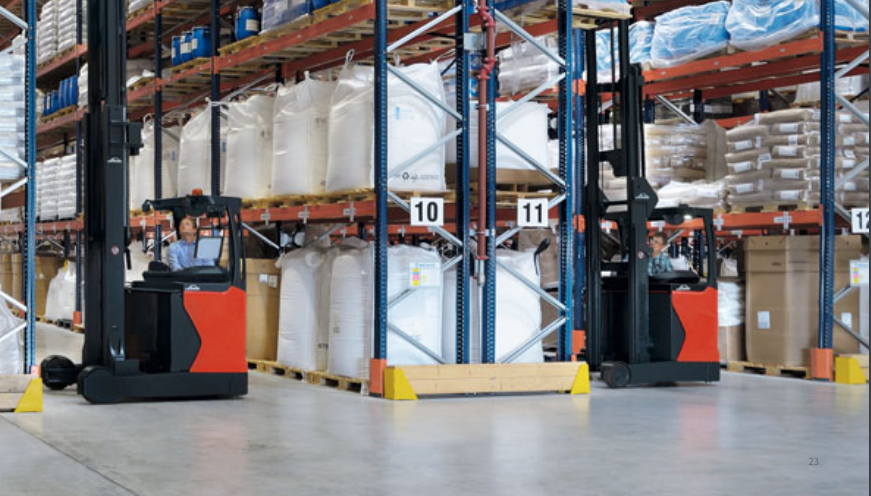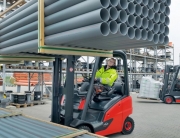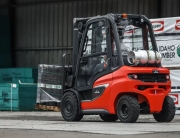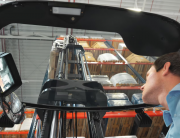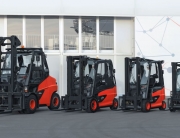Reach trucks and forklifts are both essential pieces of material handling equipment, but they serve different purposes and have distinct characteristics. In this post, we’ll delve into the key differences between reach trucks and counterbalanced lift trucks, explore the various types of reach trucks available, and discuss the different training requirements for operating these machines.
If you don’t have time to read the whole post, jump to our quick summary of reach trucks vs. forklifts.
- What Are Reach Trucks?
- What Are the Different Types of Reach Trucks?
- Reach Trucks vs. Counterbalance Forklifts
- Reach Trucks vs. Other Forklifts
- How Do You Operate a Reach Truck
- What Training Do You Need to Operate a Reach Truck?
- Summary of Reach Trucks vs. Forklifts
If you are in the market for a reach truck or any other type of forklift equipment, contact us. We can help you choose the right equipment for your needs.
Reach Trucks vs. Forklifts
1. What Are Reach Trucks?
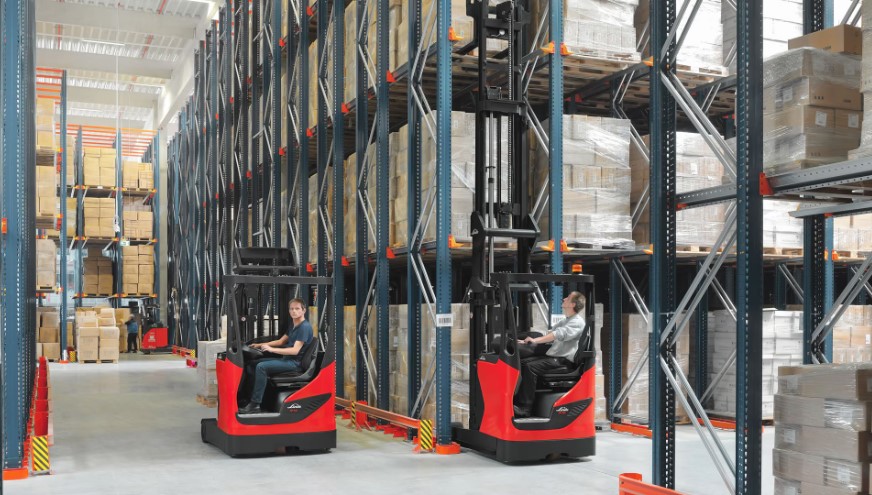
Reach Trucks vs. Forklifts: Reach trucks are a Class II forklift.
Reach trucks are a specialized type of powered industrial truck (PIT) equipped with a mechanism that enables the forks to extend horizontally. This unique feature allows reach trucks to access and handle materials in narrow aisles, making them ideal for applications where space is limited.
Are reach trucks forklifts?
Yes, reach trucks are indeed a type of forklift. However, they belong to a specific category known as:
Class II: Electric Motor Narrow Aisle Trucks.
This classification distinguishes them from other types of forklifts based on their design and operating characteristics.
The other six classifications of forklifts are:
Class I: Electric Motor Rider Trucks: These forklifts are powered by electric motors and are driven by operators. These are primarily counterbalanced electric ride on lift trucks with forks – or “forklift trucks”
Class III: Electric Motor Hand Trucks: These forklifts are also powered by electric motors but are operated by hand. These are generally also referred to primarily as Power Pallet trucks
Class IV: Internal Combustion Engine – Cushion Tire lift trucks: These forklifts are powered by internal combustion engines (like gasoline, LPG or diesel fuel) and are sit down, ride on lift trucks driven by operators in a seated position – primarily used in indoor operations.
Class V: Internal Combustion Engine – Pneumatic Tire lift trucks: These forklifts are powered by internal combustion engines (like gasoline, LPG or diesel) and are sit down, ride on lift trucks driven by operators primarily for outdoor applications where the ground is uneven and where larger outdoor tires are required. These are normally 2 wheel drive, IC powered, sit down forklift trucks in outdoor or indoor/outdoor operations.
Class VI: Warehouse Trucks: This category includes a variety of specialized equipment used in warehouses, such as electric and internal combustion engine tow tractors designed to pull loads and do not lift loads.
Class VII: Rough Terrain Forklifts: These forklifts are designed for operation on uneven ground or rough terrain, such as construction sites or outdoor storage areas. (such as on grass, gravel and / or dirt)
What do reach trucks look like?
This is a picture of a reach truck in action. This particular model is a Linde R14 X Reach truck.
How fast can a reach truck travel?
A typical 36-volt, 3,500 lb. capacity reach truck can reach a speed of approximately 7.5 mph. While this is a respectable speed for material handling applications, it’s worth noting that 3-wheel electric forklifts of the same weight and battery capacity can often travel faster, reaching speeds of around 9.9 mph.
This difference in speed is primarily due to the design and configuration of reach trucks and 3-wheel forklifts.
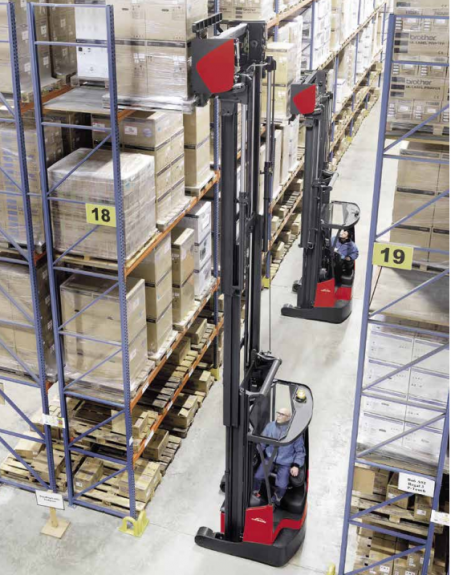
2. What Are the Different Types of Reach Trucks?
There are four primary types of reach trucks, each designed to meet specific material handling needs:
Single-Reach Truck
Description:
This is the most common type of reach truck, characterized by its ability to reach a single pallet position into racking.
Ideal for:
This type of reach truck is great for single-deep pallet storage applications.
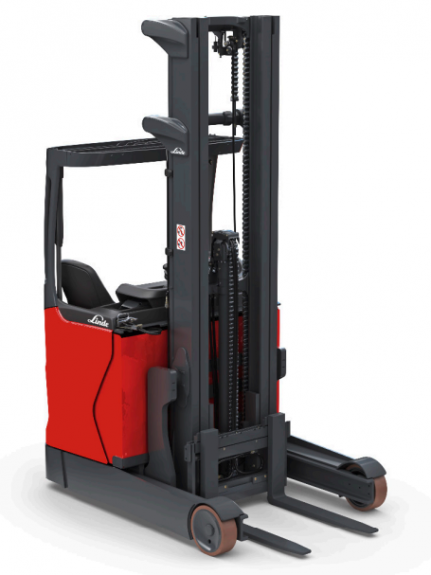
Double-Reach Trucks or Deep-Reach Trucks
Description:
Also known as deep-reach forklifts, these trucks can access two pallet positions into racking.
Advantages:
Double-reach trucks can help you increase storage density in your warehouses.
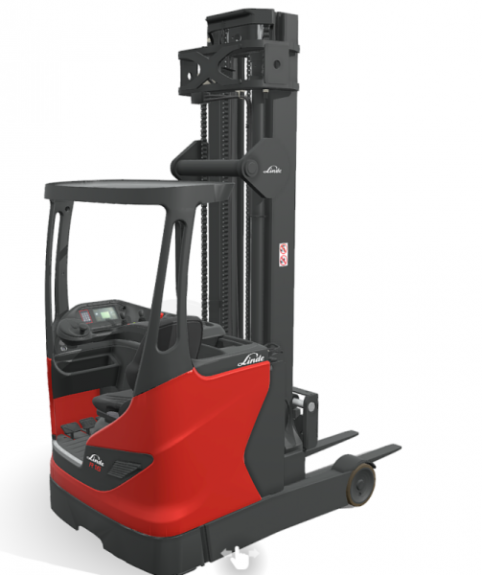
Moving Mast Reach Trucks
Description:
Instead of extending the forks, the mast on a moving mast reach truck moves forward and backward on rails.
How it works:
A hydraulic system installed on tracks above the base legs of a moving mast reach truck enables this movement.
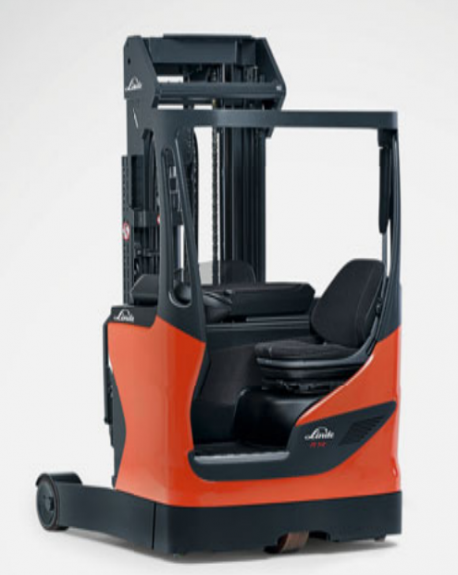
Multidirectional Reach Trucks
Description:
Multidirectional reach trucks combine features of single-reach trucks and moving mast reach trucks. The load wheels can pivot from side to side, allowing horizontal movement without turning the entire chassis.
Advantages:
This type of reach truck is ideal for handling extra-wide loads in narrow spaces.
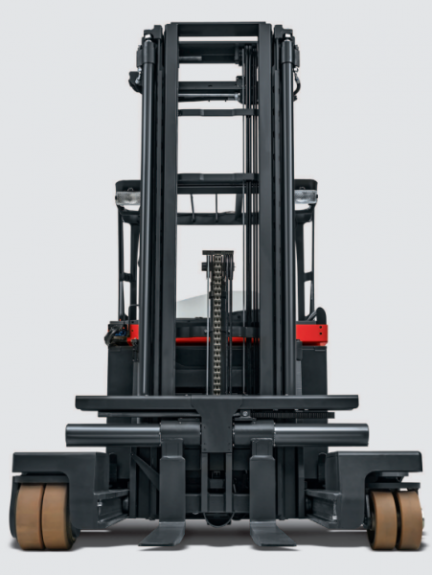
3. Reach Trucks vs. Counterbalance Forklifts
Even though a reach truck is a type of forklift, they are quite different from the most common type of forklift, counterbalance forklifts.
Fork Extension:
Reach Trucks:
The forks on a reach truck can extend horizontally, allowing operators to access pallets stored deep within racking systems. This unique feature makes reach trucks ideal for applications where space is limited, such as narrow aisle warehouses.
Counterbalance Forklifts:
The forks on a counterbalance forklift only move up and down. This design makes them more suitable for applications where pallets are stored in wider aisles or where there is more space to maneuver.
Balancing Mechanism:
Reach Trucks:
Reach trucks use base legs to balance the load, eliminating the need for a counterweight at the rear. This design allows reach trucks to have a smaller footprint and operate in narrower aisles.
Counterbalance Forklifts:
Counterbalance forklifts rely on a heavy metal counterweight at the rear to balance the load on the forks. This design requires more space to maneuver, making it less suitable for narrow aisle applications.
Operating Environment:
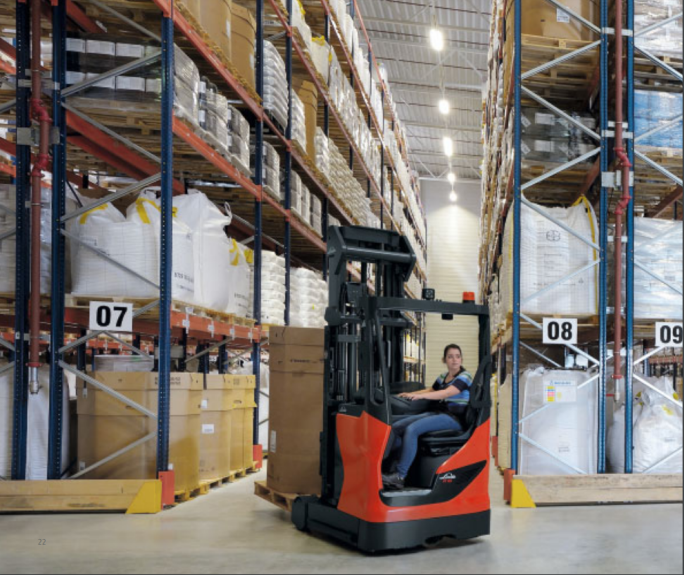
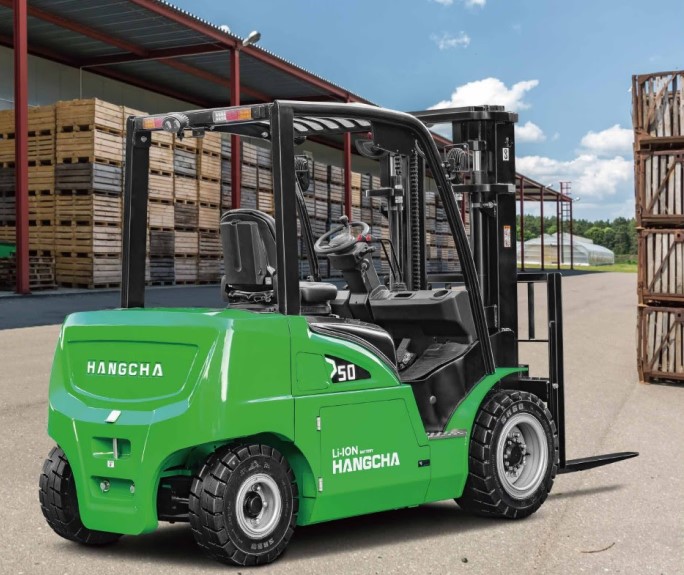
Reach trucks vs. forklifts: Forklifts can be used both inside and outside whereas reach trucks are usually used indoors.
Reach Trucks:
Reach trucks are primarily designed for indoor use on solid, smooth floors. However, some models are available for outdoor use.
Counterbalance Forklifts:
Counterbalance forklifts can be used both indoors and outdoors, depending on the type of tires they are equipped with. Cushion tires are typically used for indoor applications, while pneumatic or solid pneumatic tires are suitable for outdoor use.
Maneuverability:
Reach Trucks:
Reach trucks have a smaller turning radius and can operate in narrower aisles. This makes them ideal for applications where space is limited, such as warehouses or manufacturing facilities.
Counterbalance Forklifts:
Counterbalance forklifts have a larger turning radius and require wider aisles to maneuver. This makes them less suitable for narrow aisle applications.
Lifting Capacity:
Reach Trucks:
Reach trucks generally have lower lifting capacities compared to counterbalance forklifts. This is due to their design and the limitations of the base leg system
Counterbalance Forklifts:
Counterbalance forklifts can handle much heavier loads, often exceeding 100,000 lbs. This makes them suitable for applications that require the handling of large and heavy materials.
Fuel Sources:
Reach Trucks:
Reach trucks are exclusively electric-powered, which makes them a more environmentally friendly option.
Counterbalance Forklifts:
Counterbalance forklifts can be powered by a variety of fuel sources, including electric, liquefied petroleum gas (LPG), diesel, gasoline, and compressed natural gas (CNG). The choice of fuel source depends on the specific needs of the application and the availability of different fuel types.
Operator Position:
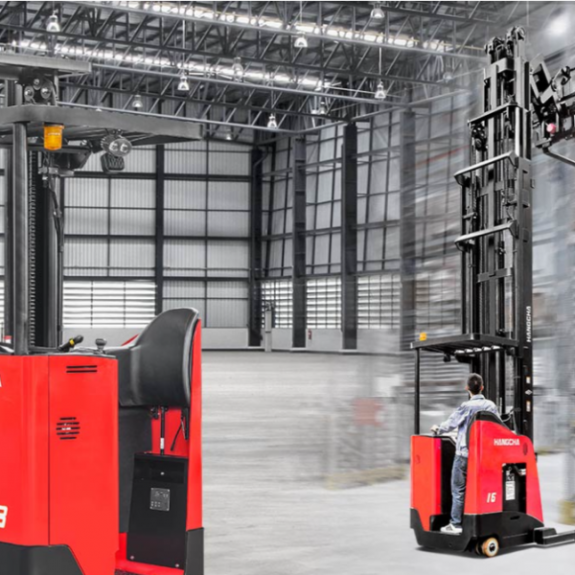
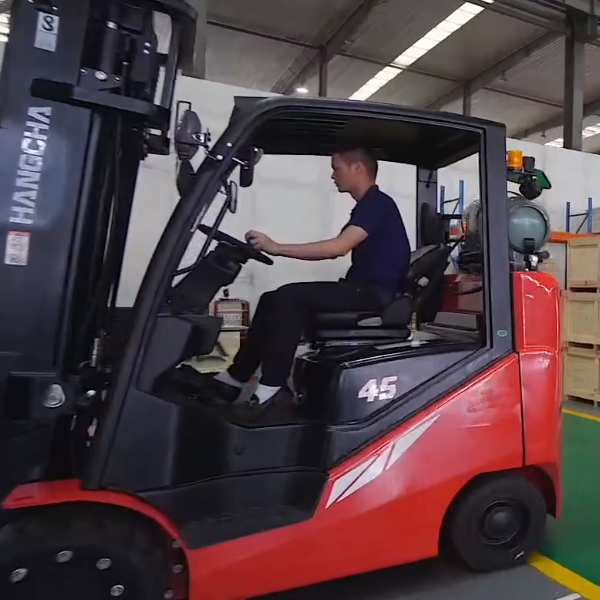
Reach trucks vs. Forklifts: Most reach trucks have the operator standing.
Reach Trucks:
Reach truck operators typically stand in a perpendicular position to the forks. This provides better visibility when travelling forward and reverse, especially when the load is blocking forward sight. However, some models of reach trucks do have a seat.
Counterbalance Forklifts:
Most counterbalance forklifts are operated from a sitting position, although some stand-up models exist. The operator’s position can vary depending on the specific model and application.
Controls:
Reach Trucks:
Reach truck controls include a steering wheel, joystick, and deadman pedal. The joystick is used to control the mast movement, fork extension, and other functions.
Counterbalance Forklifts:
Counterbalance forklift controls are similar to those found in road vehicles, with a steering wheel, gear selector, accelerator, and brake pedal. They also have hydraulic controls, which are not found on road vehicles, for operating the mast and forks.
Attachments:
Reach Trucks:
Reach trucks are generally limited to using forks on a sideshifter.
Counterbalance Forklifts:
Counterbalance forklifts can be equipped with a wide variety of attachments, including paper roll clamps, multiple pallet handlers, and bale clamps. This versatility makes counterbalance forklifts more suitable for handling a wider range of materials and applications.
Lifting Height:
Reach Trucks:
Reach trucks typically have taller masts than counterbalance forklifts, allowing them to reach higher storage locations. This makes them ideal for applications that involve storing materials in multiple levels of racking.
Reach trucks are known for their impressive lifting height capabilities. Some models can reach heights exceeding 330 inches, which is significantly taller than traditional sit-down forklifts, which typically max out around 240 inches. This additional 7 feet or more of lift height allows reach trucks to access materials stored at higher elevations in warehouses and other facilities.
Counterbalance Forklifts:
Counterbalance forklifts have a lower maximum lifting height compared to reach trucks. This makes them less suitable for applications that require the handling of materials stored at high elevations.
By understanding these key differences, you can determine which type of forklift is best suited for your specific material handling needs.
4. Reach Trucks vs. Other Forklifts
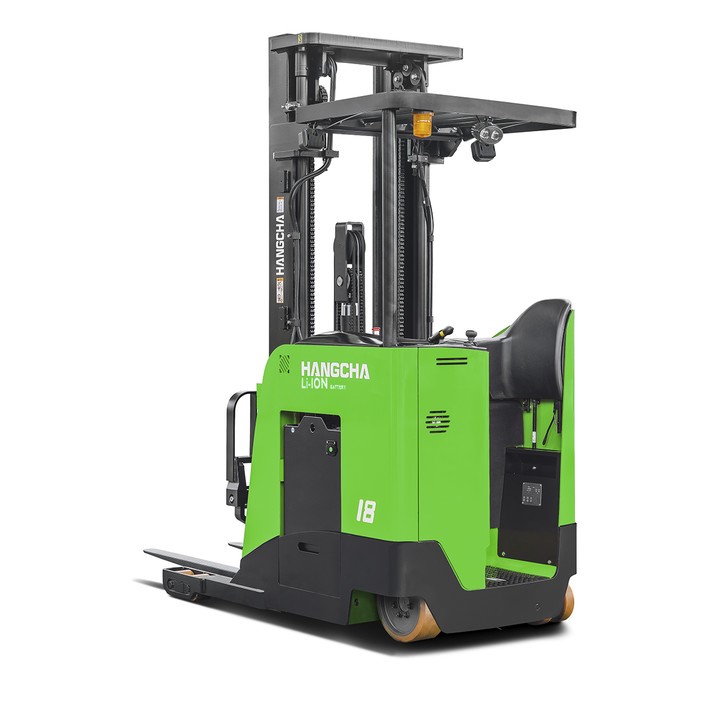
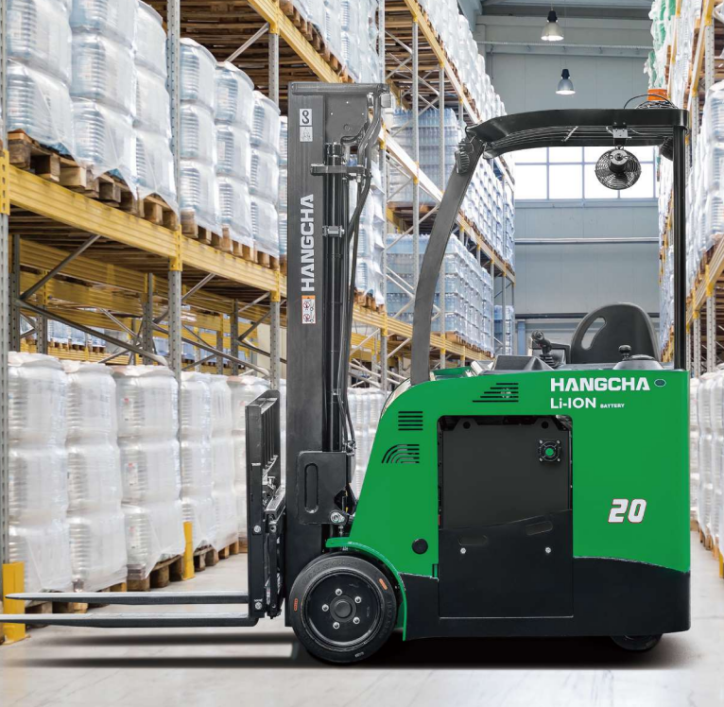
Unlike reach trucks, stand-up counterbalance forklifts do not have a pantograph mechanism.
While we’ve extensively explored the differences between reach trucks and counterbalance forklifts, it’s also important to compare them to other forklift types.
Reach Trucks vs. Stand-Up Counterbalance Forklifts
Although both reach trucks and stand-up counterbalance forklifts are operated from a standing position, there are key differences in their design and functionality:
Mast Design:
Stand-up counterbalance forklifts do not have a pantograph mechanism for extending the forks, limiting their reach into racking systems
Balancing Mechanism:
Stand-up counterbalance forklifts use a counterweight to balance the load, while reach trucks use base legs. This affects their maneuverability and lifting capacity.
Reach Trucks vs. Cherry Pickers
Cherry pickers, also known as boom lifts or order pickers, are fundamentally different from reach trucks. While reach trucks are forklifts designed to handle pallets, cherry pickers are mobile elevating work platforms (MEWP) primarily used for accessing elevated work areas.
Operator Movement:
In a reach truck, the operator stays stationary while the mast moves up and down to raise or lower a pallet. In a cherry picker, the operator moves up and down with the mast to access materials stored at various heights.
Reach Trucks vs. Stackers
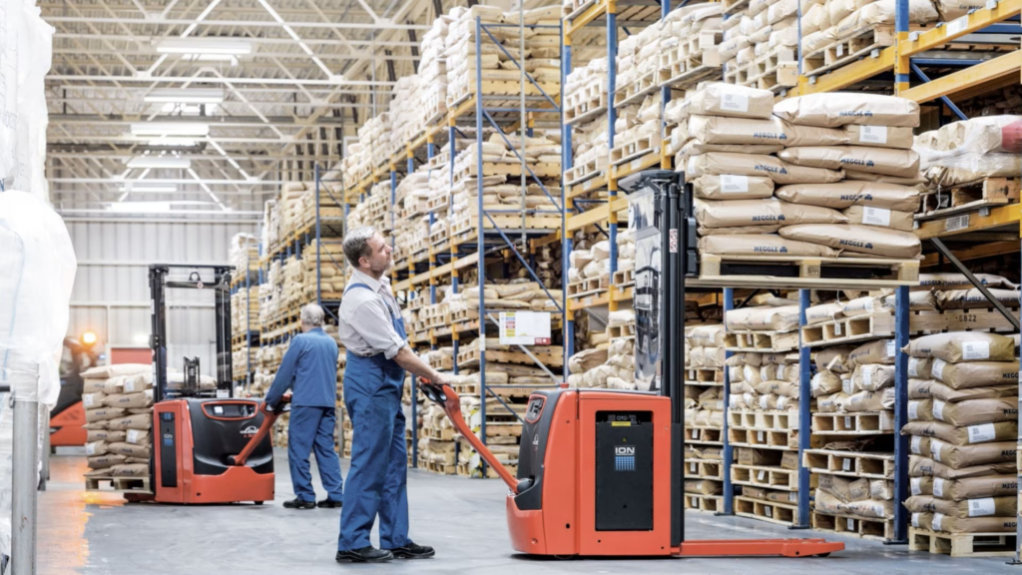
Stackers are controlled by an operator standing on the ground.
Stackers are hand-operated forklifts designed for stacking pallets. Here’s how they differ from reach trucks:
Mast Movement:
Stackers only have vertical mast movement, while reach trucks can both raise and lower the mast and extend the forks horizontally.
Operator Control:
Stackers are controlled by an operator standing on the ground and using a tiller arm. Reach trucks are operated from within the operator compartment.
Combination Stacker and Reach Trucks:
There are combination units known as walkie-reach stackers that combine the features of both stackers and reach trucks. These units have a pantograph mechanism like a reach truck but are controlled by a tiller arm like a stacker.
Reach Trucks vs. Articulated Forklifts
Both reach trucks and articulated forklifts are designed for narrow aisle applications, but they have different ways of accessing materials:
Mast Movement:
Reach trucks extend and retract the mast to access pallets, while articulated forklifts pivot the mast from side to side independently of the body.
Maneuverability:
Articulated forklifts can retrieve materials from racking without turning the entire truck chassis, while reach truck operators must turn the truck to access loads.
5. How Do You Operate a Reach Truck
Operating a reach truck requires specific skills and knowledge, as the controls and operating procedures differ significantly from traditional sit-down counterbalance forklifts. Here’s a brief overview of the steps involved in operating a reach truck:
Enter the Operator Compartment: Climb into the reach truck and secure yourself using the safety harness.
Depress the Deadman’s Pedal: Keep your foot firmly pressed on the deadman’s pedal throughout the operation. Releasing the pedal will cause the truck to automatically shut down.
Turn On the Reach Truck: Locate the ignition switch and turn it on to power the truck.
Lift the Forks: Raise the forks to a travelling position of approximately 4-6 inches off the ground.
Travel Forward or Backward: Use the joystick and steering knob to navigate the reach truck forward or backward and change the direction of travel as needed.
Raise the Forks to the Correct Level: Position the forks beneath the pallet and raise them to the appropriate height.
Extend the Forks: Use the joystick to extend the forks forward until they are securely positioned under the pallet.
Lift the Load: Carefully lift the load off the ground or pallet racking, ensuring it is clear of any obstructions.
Retract the Forks: Use the joystick to retract the forks and bring the pallet back to the closed position.
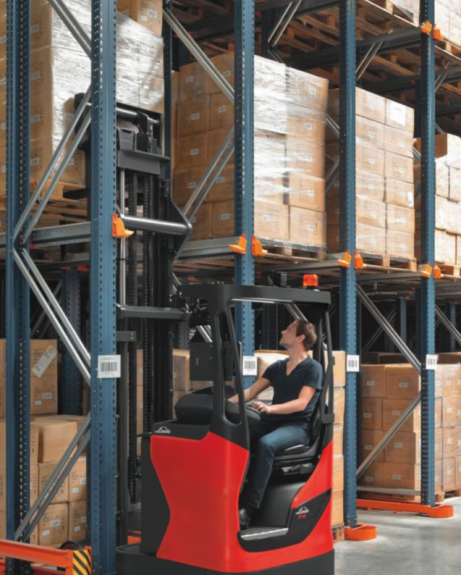
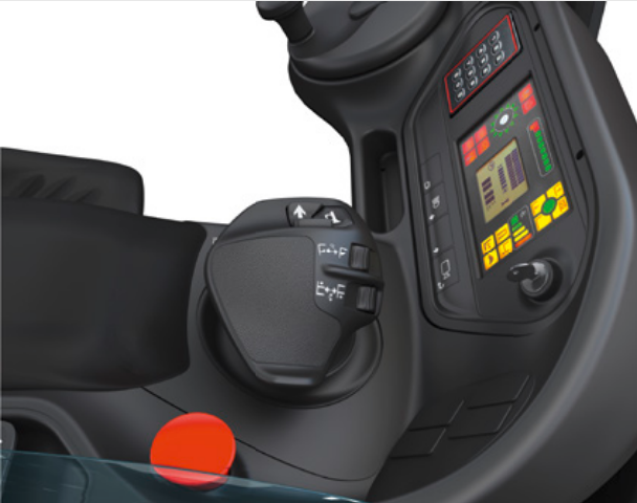
Check out a Hangcha reach truck in action.
6. What Training Do You Need to Operate a Reach Truck?
Like all other forklifts, reach trucks require specialized training and certification to operate safely and effectively. To obtain a reach truck operator license, you must meet the following requirements:
Formal Instruction
Classroom Training:
You must undergo formal instruction through classroom teaching from a certified instructor. This training covers various aspects of forklift operation, including safety precautions, maintenance, and troubleshooting.
Practical Training and Evaluation
Hands-On Experience:
In addition to classroom training, you must receive practical training and evaluation on operating a reach truck. This includes demonstrating your ability to safely and efficiently maneuver the truck, handle loads, and follow all safety procedures.
Certification
Training Course Completion:
You must complete a certified reach truck operator training course that covers the required topics outlined by Occupational Health and Safety Act (OHSA).
Employer Evaluation:
Your employer or a qualified third-party trainer must confirm that you have received the necessary training and evaluate your ability to operate a reach truck safely in your workplace.
For more information on forklift operator training and certification, please refer to our comprehensive guide: Steps for Getting a Forklift Certification in Ontario (not a license).
By completing the required training and certification, you will be qualified to operate a reach truck safely and efficiently, contributing to a productive and accident-free workplace.
7. Summary of Reach Trucks vs. Forklifts
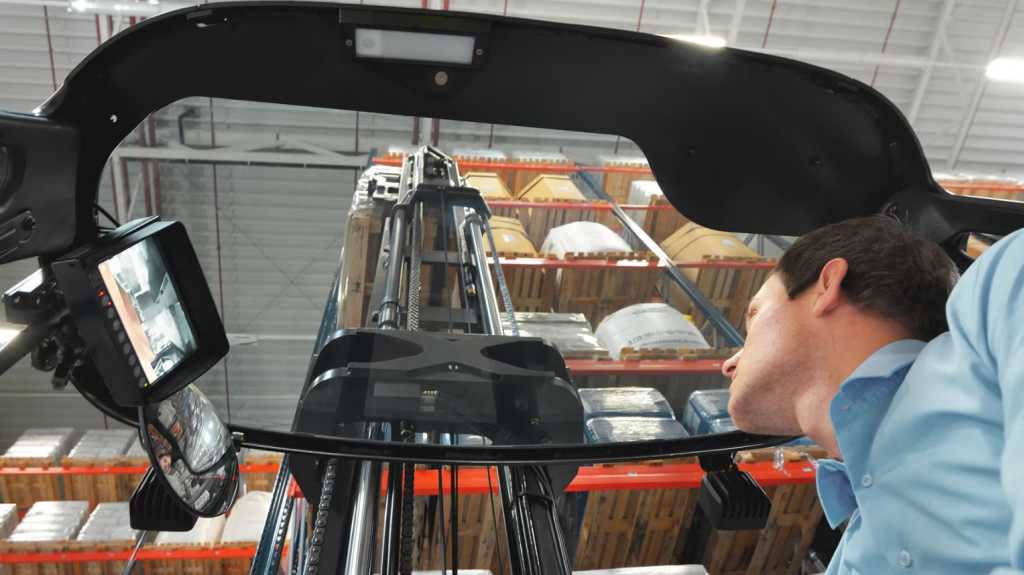
Reach Trucks are specialized forklifts designed for narrow aisle applications. They have unique features such as extendable forks and base legs, which allow them to operate in confined spaces.
Types of Reach Trucks:
- Single-Reach Trucks: For single-deep pallet storage.
- Double-Reach Trucks: For accessing two pallet positions.
- Moving Mast Reach Trucks: The mast moves forward and backward.
- Multidirectional Reach Trucks: Can move horizontally without turning the entire chassis.
Reach Trucks vs. Counterbalance Forklifts:
- Fork Extension: Reach trucks can extend forks horizontally.
- Balancing Mechanism: Reach trucks use base legs, while counterbalance forklifts use a counterweight.
- Operating Environment: Reach trucks are primarily for indoor use.
- Maneuverability: Reach trucks are more maneuverable in narrow aisles.
- Lifting Capacity: Counterbalance forklifts have higher lifting capacity.
- Fuel Sources: Reach trucks are electric-powered, while counterbalance forklifts have various fuel options.
- Operator Position: Reach trucks are typically stand-up operated.
- Controls: Reach trucks have unique controls including a joystick and deadman pedal.
- Attachments: Reach trucks have limited attachments compared to counterbalance forklifts.
- Lifting Height: Reach trucks generally have taller masts.
Reach Trucks vs. Other Forklifts:
- Stand-Up Counterbalance Forklifts: Similar design but without pantograph mechanism and base legs.
- Cherry Pickers: MEWPs for accessing elevated work areas.
- Stackers: Hand-operated forklifts for stacking pallets.
- Articulated Forklifts: Counterbalance forklifts with pivoting masts for narrow aisle applications.
Operating a Reach Truck:
- Training: Requires specialized training and certification.
- Steps: Enter the compartment, depress the deadman’s pedal, turn on the truck, lift the forks, travel to the pallet, raise the forks, extend the forks, lift the load, and retract the forks.
Reach Truck Training:
- Formal Instruction: Classroom training from a certified instructor.
- Practical Training and Evaluation: Hands-on training and assessment.
- Certification: Completion of training and evaluation by an employer or third-party trainer.
y understanding the differences between reach trucks and other forklift types, you can select the most suitable equipment for your specific material handling needs.
For the Best Selection of Reach Trucks and Other Forklifts – Contact Ri-Go.

If you are in the market for a new or used forklift, contact us. We have a wide selection including reach trucks, and our knowledgeable staff can help you choose the perfect unit for your needs.
Since 1977, Ri-Go Lift Truck has been serving customers in Ontario and Quebec with everything they need for material handling. We are committed to providing you with quality service and a high level of customer satisfaction.
We are your authorized dealer for the following top brands:
- Linde Lift Trucks, Power Pallet Trucks, Tow Tractors and Stackers
- Hangcha – Full Line-up Including Lithium-Ion
- Blue Giant Lift Trucks and Pallet Movers
- Komatsu Forklifts and Reach Trucks
- Mariotti Lift Trucks – The Worlds Smallest Lift Truck
- Baoli Lift Trucks
- Advance Sweepers and Scrubbers
- Skyjack Genie Booms and Scissor Lifts
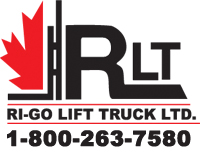
In addition to our authorized distributorships, we can also provide you with:
- Large selection of used forklifts
- Operator Training Department – open 7 days a week
- Parts Departments – over $1.9 million dollars of parts on hand for all makes and models
- Service Department – highly trained technicians
- Leasing and Rentals
No matter what your material handling needs are, we can help. Contact us today to let us know how we can be of service.
What Our Customers Think…
“Over 20 years doing business with Ri-go, in maintaining and renting us industrial power equipment. A big business with a real family way of treating the customers. They are experts in the industries they are involved in, and have been an important supplier for me for years. Moving forklifts, installing battery hoists, repairs, etc. If it’s something they don’t normally do, they make the effort to find us someone who can. Very very happy with everyone at Ri-Go.” -Paul Heggie



